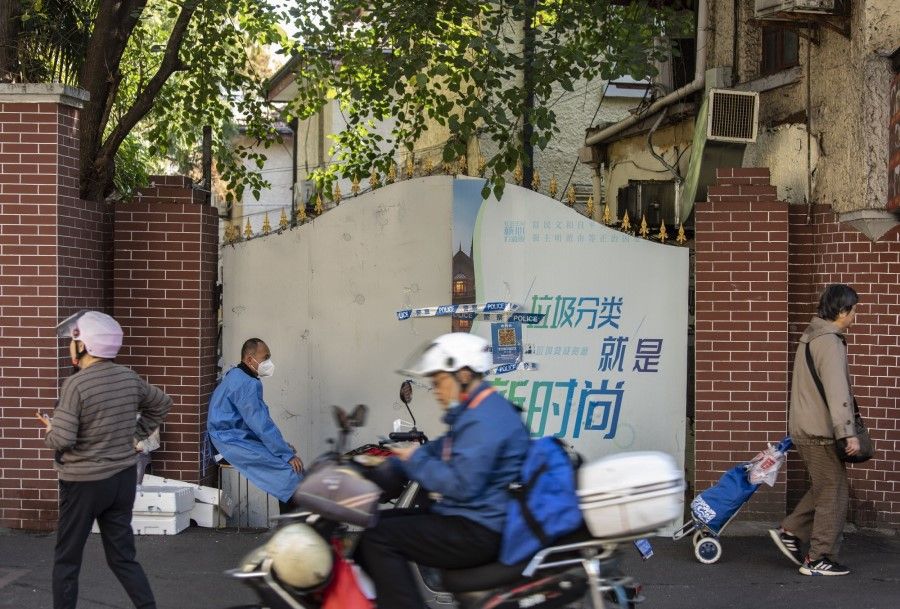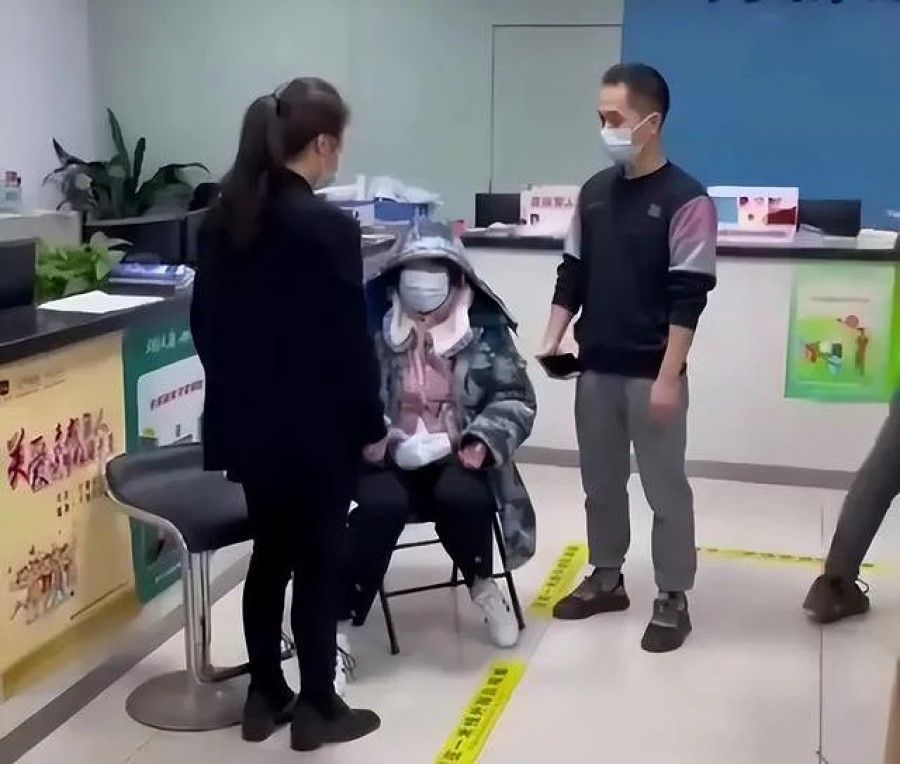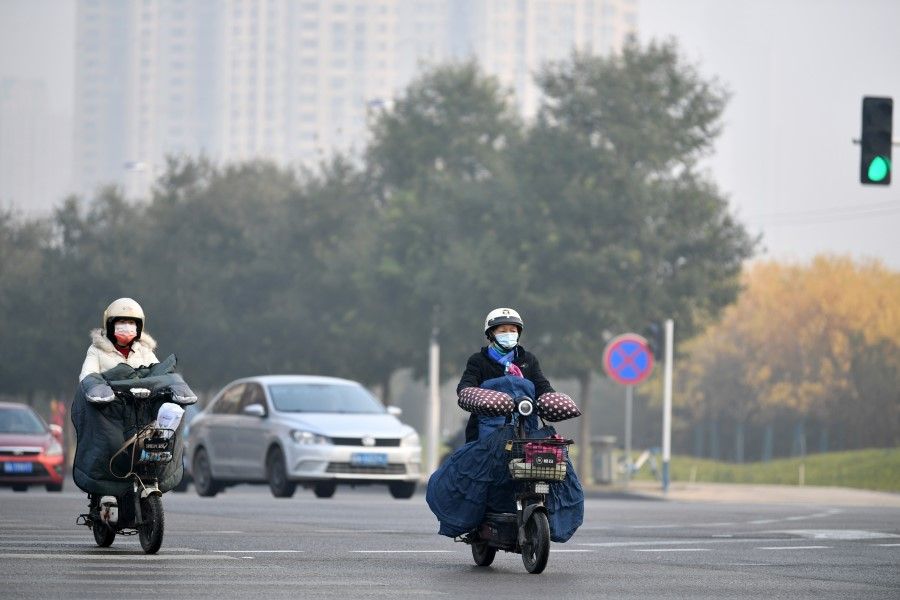Chinese local governments struggle to find perfect way to ease pandemic rules

On 11 November, the Chinese authorities announced 20 new measures to improve Covid-19 control efforts, adjusting border controls and domestic management measures towards a more science-based and precise approach.
But after the initial short-lived relief of "improved" control measures, with the authorities reiterating that the "20 measures" do not mean that the country is "lying flat", and the "dynamic zero-Covid" approach will continue, many people realised that the local implementation of the measures is not as smooth as imagined.
Social media posts by Chinese netizens reveal that the adjustments to some of China's domestic control measures have been effective to varying degrees in different places. Some areas have promptly implemented several new measures, such as no longer identifying secondary close contacts or isolating close contacts unnecessarily; but people in many places have not yet felt any real changes, some even found the adjusted measures more troublesome.
Differences in understanding and implementation of measures
After the State Council released the 20 new measures on 11 November, several provinces and cities held meetings on the same day to follow up.
According to non-exhaustive information, Beijing, Guangdong, Henan, Hebei, Hainan, Shandong, Jilin, Jiangxi and Jiangsu immediately held meetings to discuss the 20 measures, while Chongqing and Shanghai held meetings on 12 and 13 November respectively.
... most of the other measures are not easily implemented, as they are mostly guidance- or principle-based.

The various provinces and cities each had different views on the new measures. Beijing and Guangzhou said that they would "seriously implement" the 20 new measures, while Hebei and Xinjiang said that they would follow the general guidelines but adjust the measures according to the local situation.
In fact, a close look at the new measures would show that among the domestic control measures, besides no longer identifying secondary contacts, removing the "medium-risk area" category, and adjusting quarantine periods for close contacts and people from or working in high-risk areas, most of the other measures are not easily implemented, as they are mostly guidance- or principle-based.
For example, while the new measures state that generally there is no need for area-based mass testing, it is still allowed in certain cases, such as when the source and infection chain are unknown, or during a protracted community spread. It will be up to the local disease control agency to assess and make decisions.
For instance, Tianjin began citywide mass testing on 13 November after reporting two new confirmed cases and 58 asymptomatic cases the previous day. In contrast, neighbouring Beijing saw 161 confirmed cases and 74 asymptomatic cases on the same day but did not carry out mass testing.
Such guidance- or principle-based measures give room for grassroots agencies to make adjustments according to the situation on the ground, but also lead to variances in the understanding and implementation of the measures between places.
Urumqi and Chongqing: no easing of controls?
With several areas moving towards easing Covid-19 control policies following the introduction of the new measures, Urumqi in the Xinjiang Uygur Autonomous Region remains an outlier.

It has been nearly 100 days since Urumqi went under lockdown around 10 August, and the prolonged lockdown has severely disrupted the people's daily life, for which the local authorities have apologised. However, there have been no real improvements following the announcement of the 20 measures.
The local authorities also announced that there is still a risk of hidden community spread and the results of the control measures are not conclusive enough despite the improving Covid-19 situation in Urumqi...
Even though the local authorities announced on 12 November that 357 high- and medium-risk areas would be categorised as low-risk areas in accordance with the new measures, there was no mention of when the lockdown would be lifted in these areas and return to normal life.
The local authorities also announced that there is still a risk of hidden community spread and the results of the control measures are not conclusive enough despite the improving Covid-19 situation in Urumqi - confirmed Covid-19 cases outside of quarantine control areas have gradually decreased; the number of residential compounds with new positive cases are declining; more people are being discharged from hospitals; and several residential compounds have lowered control levels according to the new measures.
Urumqi - with a resident population of four million - has long been under "quiet management". The city posted 20 new confirmed cases and 611 asymptomatic cases on 13 November, which went down to six new confirmed cases and 325 asymptomatic cases on 20 November.
The announcement of the 20 measures prompted netizens to question the effectiveness of quiet management measures in curbing the spread of the virus, and criticise that areawide lockdowns are a gross oversimplification and one-size-fits-all approach in virus control. In addition, they stress that refusing to lift lockdowns is going against the new measures.
Following the announcement of the 20 measures, Chongqing has also been mired in controversy amid its Covid-19 outbreak.
According to online sources, on the morning of 12 November, a pregnant woman in Xiangshan residential district in Chongqing felt unwell and called for emergency help. However, after hours of waiting for the ambulance, she eventually suffered a miscarriage at the hospital in Jiulongpo district, leading to speculation that the additional layers of controls caused delays in getting her to the hospital.

On 14 November, the local authorities refuted online claims that the ambulance was blocked from entering the residential compound, but noted that communications between the community workers and transport were not timely and accurate, and community workers were not effective, causing the delay in vehicles entering the compound.
The local authorities further said that an apology had been made to the woman, who understood the situation. The day after the reported incident, Chongqing announced requirements to ensure that the public are able to get prompt medical attention, and unimpeded passage during emergency situations is allowed for pregnant women and critically ill patients, as well as their caregivers. But public opinion has not been forgiving.
On Weibo, many netizens lamented the loss of a life, and criticised the difficulty in getting through the hotline, the slow responses and the lack of improvement in the shortcomings, which clearly goes against the spirit of the 20 new measures towards science-based Covid-19 controls, thus raising doubts about the additional layers of measures locally.
Beijing and Zhuhai: chaotic implementation
As for the cities that have chosen to implement the 20 measures, the adjusted policies have also brought about confusion and inconvenience to residents. The first to feel the impact is the capital Beijing, where the virus is still rampant.
On the morning of 14 November, many people in Beijing's Chaoyang district who intended to get tested on their way to work were surprised to find that several testing booths had suspended services. The few that remained open as well as those within residential compounds saw queues hundreds of metres long.

They posted online to ask where they could get tested, since entry into many offices and public places in Beijing requires a negative test result taken within 24 hours. As for some who took the test the night before and could enter workplaces with a valid result, they faced issues returning home in the evening. They wryly described that it felt like they were pinned in place by the conflicting policies, saying, "We might as well quietly stay at home."
Around noon that day, the Chaoyang authorities released a notice saying that after some areas in Chaoyang were designated as low risk according to the new measures, testing points were relocated closer to residential areas for the convenience of residents. While the notice said that there were more testing and passage points, residents remained sceptical.
Many netizens said that the testing points in their compounds only operated from morning until noon, or at most 6pm, which was inconvenient for working persons who needed to commute - many had to take time off work to get tested. Some netizens questioned if such arrangements made sense as long queues and big crowds of people getting tested would form in the compound.

Also, people in Guangzhou's Zhuhai, another infection hotspot in southern China, had to look at their maps in the early hours of 14 November, when the lockdown was scheduled to be lifted, to check if they could in fact leave the little island that was separated from the main city by the Pearl River. The answer: probably not, because the bridges and roads across the river were still cordoned off.
Chinese people in dilemma
Former Global Times editor-in-chief Hu Xijin - an enthusiastic current affairs commentator who often shares his views on China's Covid-19 controls and issues - also made several posts on Weibo after the 20 measures were announced, remarking that their implementation would be very tough.
On 12 November, Hu wrote that while the authorities' principles on Covid-19 controls were clear following the press conference, it would be difficult to implement immediately.
He noted that local governments would have to figure out how to control the outbreaks while minimising the impact on the economy, society and daily services, all within the scope of the general principles and basic measures, which puts greater pressure on local Covid-19 controls.
And in a subsequent Weibo post on 13 November, Hu was concerned about the people's threshold for tolerating strict controls. He felt that a short period of quiet management was understandable, but prolonged lockdowns were undesirable and went against the science-based approach. But at the same time, he said that a large-scale outbreak could also spark panic and disrupt productivity.
Hu made two more posts on 14 November to share his view on how Beijing and Shijiazhuang have handled the Covid-19 outbreaks.
On Shijiazhuang, which has chosen to "open up" despite a severe outbreak and rising cases, Hu said that public information is currently in disarray, while people are insecure and unaccustomed to "opening up", and still fearful of going outside.
... Hu's conflicting comments precisely show the contradictions in China's attempt to move towards a more scientific and open Covid-19 strategy...

He urged people not to panic, and to trust that the local authorities will follow the 20 measures without ignoring public safety.
In another Weibo post, Hu expressed concern that the virus is still rampant in Beijing. He said that if Beijing chooses to implement quiet or semi-quiet management on a wide scale, that would be a hit to China's precise Covid-19 controls, and a setback to the implementation of the new measures. So, he hoped that Beijing would stick to precise Covid-19 controls and pave the way forward for China.
In fact, Hu's conflicting comments precisely show the contradictions in China's attempt to move towards a more scientific and open Covid-19 strategy: whether the policies from the top can be properly implemented on the ground, and whether the Chinese public who are accustomed to strict zero-Covid measures and still see the virus as a serious threat will be able to accept the changes towards science-based controls.
Long journey ahead
Evidently, the 20 new measures are a small but important step in easing Covid-19 controls. There is still a long way to go until the policy is fully implemented locally, the benefits to the people are felt, and continued easing is followed through.
Indeed, there will be several roadblocks along the way. For example, will the public panic over the increase in cases that come with easing? Would the implementation of the policy be affected if local officials are held accountable for the spread of the virus and rising cases?
The impact of strict controls on the economy and daily life can no longer be ignored. Following this first step by the authorities towards easing, it will be difficult to go back to tightening controls. Nonetheless, it will be a tough road ahead towards opening up and connecting with the international community, but it is necessary in order for China's development to move beyond the impact of the pandemic.
Starting off is always the hardest. A line from Chinese President Xi Jinping is also befitting China's journey towards science-based Covid-19 controls: "The path is long and full of obstacles, but we will reach our destination; as long as we keep moving, we can look forward to the future."
This article was first published in Zaobao as "'二十条'大路通何方?".
